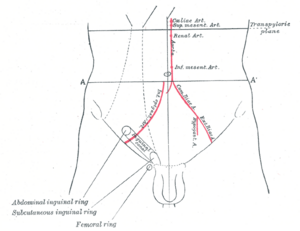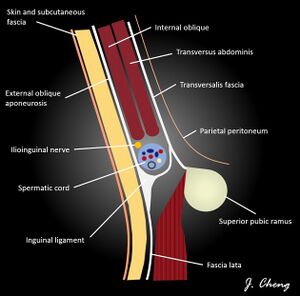Inguinal Canal: Difference between revisions
No edit summary |
No edit summary |
||
| Line 6: | Line 6: | ||
<div class="noeditbox">This article or area is currently under construction and may only be partially complete. Please come back soon to see the finished work! ({{REVISIONDAY}}/{{REVISIONMONTH}}/{{REVISIONYEAR}})</div> | <div class="noeditbox">This article or area is currently under construction and may only be partially complete. Please come back soon to see the finished work! ({{REVISIONDAY}}/{{REVISIONMONTH}}/{{REVISIONYEAR}})</div> | ||
== Introduction == | == Introduction == | ||
[[File:Inguinal canal DIAGRAM.png|thumb]] | |||
The inguinal canal (IC) is an oblique triangular shape in the lower aponeurosis of the external obliquis muscle about 3-5 cm in length, it is superior and parallel to the inguinal ligament. Situated at the inferior part of the abdominal wall and extended medially and inferiorly. | The inguinal canal (IC) is an oblique triangular shape in the lower aponeurosis of the external obliquis muscle about 3-5 cm in length, it is superior and parallel to the inguinal ligament. Situated at the inferior part of the abdominal wall and extended medially and inferiorly. | ||
| Line 23: | Line 24: | ||
<u>Superficial inguinal ring:</u> the end of the inguinal canal found 1 cm superolateral to the pubic tubercle, it is a defect in the aponeurosis of the external obliquis, this ring surrounded medially by rectus abdominis its (inferolateral border), laterally by inferior epigastric vessel, and medial inguinal ligament inferiorly forming a triangle called inguinal triangle that is a land mark of the superficial ring. | <u>Superficial inguinal ring:</u> the end of the inguinal canal found 1 cm superolateral to the pubic tubercle, it is a defect in the aponeurosis of the external obliquis, this ring surrounded medially by rectus abdominis its (inferolateral border), laterally by inferior epigastric vessel, and medial inguinal ligament inferiorly forming a triangle called inguinal triangle that is a land mark of the superficial ring. | ||
[[File:Inguinal canal.jpeg|thumb|Inguinal canal relations and contents]] | |||
== Contents == | == Contents == | ||
| Line 40: | Line 42: | ||
'''Neoplasms''', may develop from any structures of the canal. | '''Neoplasms''', may develop from any structures of the canal. | ||
'''varicosities''' of round Ligament in females, and varicoceles in males | '''varicosities''' of round Ligament in females, and varicoceles in males<ref>Revzin MV, Ersahin D, Israel GM, Kirsch JD, Mathur M, Bokhari J, Scoutt LM. [https://pubs.rsna.org/doi/full/10.1148/rg.2016150181 US of the inguinal canal: comprehensive review of pathologic processes with CT and MR imaging correlation]. Radiographics. 2016 Nov;36(7):2028-48.</ref>. | ||
== Resources == | == Resources == | ||
Revision as of 02:38, 1 August 2021
Original Editor - User Name
Top Contributors - Khloud Shreif and Kirenga Bamurange Liliane
Introduction[edit | edit source]
The inguinal canal (IC) is an oblique triangular shape in the lower aponeurosis of the external obliquis muscle about 3-5 cm in length, it is superior and parallel to the inguinal ligament. Situated at the inferior part of the abdominal wall and extended medially and inferiorly.
Divided into superficial and deep inguinal canal, becomes superficial as it passes from medial to lateral through penetrating the inguinal canal. It is a common site for herniation surrounded by 4 boundaries. If there is an increase in the intra-abdominal pressure forces the posterior wall to compress against the anterior wall seeking to strengthen it to avoid herniation.
Boundaries[edit | edit source]
Anterior wall: skin, superficial fascia, aponeurosis of external obliquis, and part of the internal obliquis muscle.
Posterior wall: the conjoint tendon ( the insertion point of the external and internal obliquis muscles) most medial and transvesalis fasci lateral to it.
Roof/ superior wall: arching fibers of internal obliquis and transversalis fascia.
Inferior wall: medial part of the inguinal ligament.
Openings[edit | edit source]
Deep/ lateral inguinal ring: located above the midpoint of the inguinal ligament, lateral to the epigastric vessels, it considered as a defect in the transversalis fascia developed at embryology, and terminates superolateral to the pubic tubercle by the superficial ring. When there is an increase in the intra-abdominal pressure the IO muscle contracts making the canal taut.
Superficial inguinal ring: the end of the inguinal canal found 1 cm superolateral to the pubic tubercle, it is a defect in the aponeurosis of the external obliquis, this ring surrounded medially by rectus abdominis its (inferolateral border), laterally by inferior epigastric vessel, and medial inguinal ligament inferiorly forming a triangle called inguinal triangle that is a land mark of the superficial ring.
Contents[edit | edit source]
- Illioinguinal nerve, lymph, and blood vessels in both sex.
- Spermatic cord in male
- Round ligament of uterus in female
Clinical Relevance[edit | edit source]
- Direct hernia, protrusion of abdominal viscera through the posterior wall, it is acquired during adulthood.
- Indirect hernia, protrusion of abdominal viscera through the deep inguinal ring, the common type and represents about 50% and more liable to be congenital most common on the right side.
Inguinal endometriosis, in cases with inguinal canal stroma and ectopic endometrail glands.
Neoplasms, may develop from any structures of the canal.
varicosities of round Ligament in females, and varicoceles in males[1].
Resources[edit | edit source]
References[edit | edit source]
- ↑ Revzin MV, Ersahin D, Israel GM, Kirsch JD, Mathur M, Bokhari J, Scoutt LM. US of the inguinal canal: comprehensive review of pathologic processes with CT and MR imaging correlation. Radiographics. 2016 Nov;36(7):2028-48.








